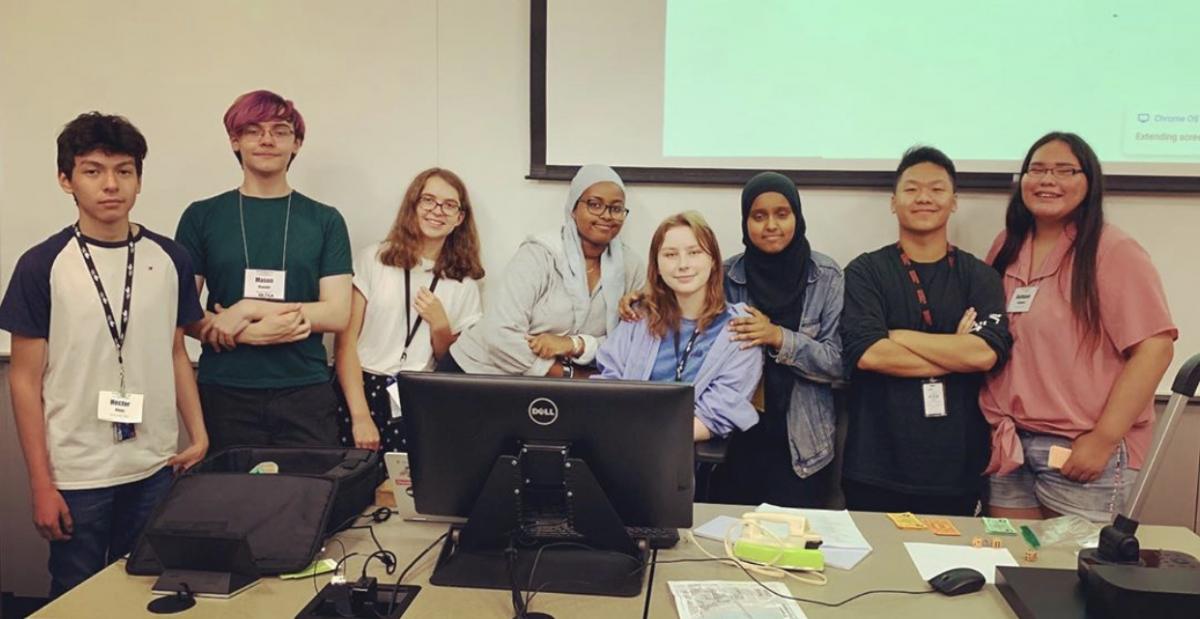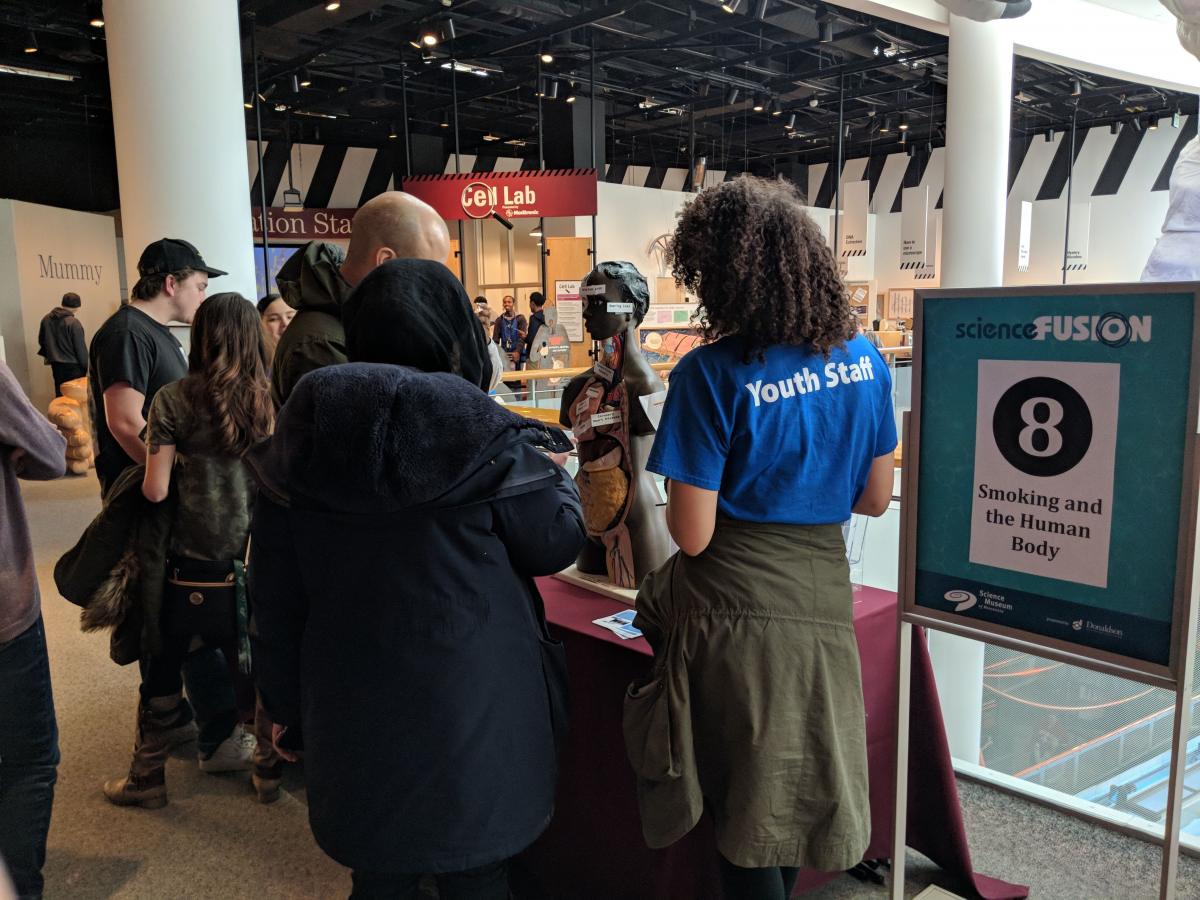Growing STEM Justice through Research and Practice
Written by Shannon McManimon with contributions from Choua Her, Zdanna King, Joseph Adamji
The Kitty Andersen Youth Science Center (KAYSC) at the Science Museum of Minnesota (SMM) aims to “empower youth to change our world through science.” The KAYSC is a long-term, out-of-school-time (OST) pathway program for youth who are under-represented in STEM (girls, BIPOC, and youth from low-income families). It pairs STEM and social justice so that young people can use STEM to make tangible, positive impacts in their communities.
As KAYSC staff and learning researchers at SMM, we wanted to understand its learning practices and their relationship to the theory of science capital (Archer, DeWitt, & Willis, 2014). The research-to-practice project STEM Justice: Investigating a Model for Building Youth Science Capital (NSF DRL #1612782) engaged high-school-aged youth and adult practitioners and researchers in documenting, analyzing, and refining the KAYSC's approach to STEM Justice. STEM Justice is a movement to redefine STEM as a tool for dismantling systems of oppression and constructing collective liberation.
Our four-year project was concerned with increasing equity and access in informal science education (ISE), as well as broadening methodologies. We attempted to do research differently and to think about STEM expansively, as multiple stakeholders contributed to iterative programmatic design in the KAYSC and then with an OST partner, Youth Farm.
(Image: ASTC workshop participants; photo credit Jordan Lee Thompson)
What Is This Research Thing?
We wanted to do research differently: to position all of us as co-researchers who brought our expertise and ways of knowing to our shared work. For many people, the term “research” conjures a history of abusive, extractive, and unethical practices, often done on, rather than with or by participants. We took these realities seriously and made a particular effort to be transparent around access to and use of data.
We made mistakes. We learned from them. For instance, we learned that truthfully answering “we don’t know” to questions sometimes made it sound like we did not know what we were doing or were wasting time. We let go of the methodology we initially chose, despite its fit on paper, because it was not serving us or our project. Instead, we called what we were doing participatory research.
We also got serious about practice: whatever we did needed to also meet goals for practitioners’ work, particularly with young people. We borrowed the idea of embedded assessment from informal learning. We began to call much of our nontraditional data generation (simultaneously the co-designing of processes and products) embedded research practices. Embedded research practices (McManimon, 2021) drew on informal educators' existing practices, involved KAYSC practitioners in all aspects of research, modeled tools for programming, and reflected shared social justice commitments.
Building Relationships, Trust, and Shared Languages

Encouraged by our external evaluator, we spent much time developing shared languages and practices, as well as a group identity and trust. People’s mistrust of research, as well as logistical challenges endemic to participatory research and youth work, made it particularly important for us to collaboratively build our own language, rather than worrying about academic terms. We defined research and data and even science/STEM for ourselves. We onboarded new staff around this language.
Our Research Advisory Board encouraged us to explicitly name shared practices. Because nearly all of us had been around the KAYSC for a while, what happened there was normalized to us, yet it was not necessarily “normal” in OST STEM learning. As one advisor said, the “things that seem like ‘nothing’ are possibly everything” in understanding the STEM Justice approach. For example, social justice was so foundational to us that we sometimes forgot to name it. We recognized the following as crucial to STEM Justice: a commitment to diverse staffing reflecting the communities of KAYSC youth; a welcoming, family feeling; a holistically supportive space that attended to family and personal needs; collaboration, shared norms, and opportunities to reshape oppressive narratives; and STEM content grounded in young people's lives, interests, and communities. (Image: KAYSC youth presenting at Free Minds, Free People; photo credit KAYSC staff)
Responding to ISE Contexts: Research as Catalyst for Professional Learning
Our participatory research processes created intentional space for people to engage in collaborative reflection and to voice their often unspoken challenges and needs, as practitioners who intended to create “powerful learning experiences that youth experience as passion.” One KAYSC leader reported that this sanctioned time for deep conversations “forces us to think differently about the work, which forces us to talk differently about the work....It’s been a good driver and compass.”.
This prompted even more change. About 1.5 years into the project, inspired in part by project conversations, we redesigned the high school youth program. We had started a research project investigating a program that was in practice now quite different.
This change helped us identify a need for foundational training and professional learning for practitioners. To implement a STEM Justice approach that met the needs of young people, adult staff needed education and ongoing reflection on practice. Our research–practice project responded by creating STEM Justice curriculum and programming for both internal and external constituencies. Our participatory research was also professional learning. When we shared materials we developed with Youth Farm, they told us the same.
Theory into Practice: Science Capital Becomes STEM Capitxl
Redefining research and a commitment to shared languages also led us to rename academic theory to center relevance for STEM Justice practitioners. The term STEM capitxl (see McManimon, Her, & Adamji, 2019) signals the theory's roots in equity, invites questioning, and documents opposition to systematic oppression. It reflects asset- and community-based approaches, reclaims the STEM knowledge and practices of multiple communities, and reflects KAYSC's pedagogical practices and content areas. STEM capitxl is a practical and pedagogical tool to help practitioners name the STEM in what they are doing and in young people's lives and to reflect upon how programming embeds STEM dispositions, practices, and knowledge in the service of social justice.

Growing a STEM Justice Movement
The STEM Justice research project iteratively developed and disseminated a toolkit and trainings at the intersection of STEM, learning, and social justice. These resources for equity-focused learning environments articulate the what, why, and how of STEM Justice. These materials are being used internally to further the museum's commitment to equity-based STEM, as well as externally in the KAYSC’s new STEM Justice coaching model for OST and learning professionals. Importantly, this work is helping OST professionals, like those at our partner Youth Farm, to understand and name how their work is already STEM. (Image: SMM museum floor, photo credit KAYSC staff)
References
Archer, L., DeWitt, J., & Willis, B. (2014). Adolescent boys’ science aspirations: Masculinity, capital, and power. Journal of Research in Science Teaching, 51(1), 1–30.
McManimon, S. K. (2021). Embedded research practices: Practice as process, participatory method, and product in informal learning research. Journal of Museum Education, 46(2), 245–254. https://www.tandfonline.com/
McManimon, S. K., Her., C., & Adamji, J. (2019). Practicing STEM capitxl with an out-of-school-time youth program. Science for the People, 22(2), 20–25.